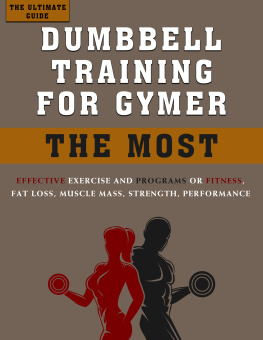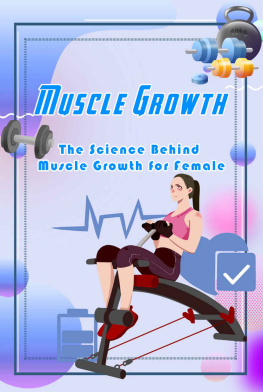
Science and Development of Muscle Hypertrophy
Brad Schoenfeld, PhD, CSCS, CSPS, FNSCA
Lehman College, Bronx, New York

Library of Congress Cataloging-in-Publication Data
Schoenfeld, Brad, 1962- , author.
Science and development of muscle hypertrophy / Brad Schoenfeld.
p. ; cm.
Includes bibliographical references and index.
I. Title.
[DNLM: 1. Muscle Development--physiology. 2. Exercise. 3. Physical Fitness. WE 500]
QP303
612.7'6--dc23
2015035559
ISBN: 978-1-4925-1960-7
Copyright 2016 by Brad Schoenfeld
All rights reserved. Except for use in a review, the reproduction or utilization of this work in any form or by any electronic, mechanical, or other means, now known or hereafter invented, including xerography, photocopying, and recording, and in any information storage and retrieval system, is forbidden without the written permission of the publisher.
Acquisitions Editor: Roger W. Earle
Senior Developmental Editor: Christine M. Drews
Managing Editor: Karla Walsh
Copyeditor: Patsy Fortney
Indexer: Patsy Fortney
Permissions Manager: Dalene Reeder
Senior Graphic Designer: Keri Evans
Cover Designer: Keith Blomberg
Photographs (interior): Human Kinetics, unless otherwise noted
Photo Asset Manager: Laura Fitch
Photo Production Manager: Jason Allen
Senior Art Manager: Kelly Hendren
Associate Art Manager: Alan L. Wilborn
Illustrations: Human Kinetics, unless otherwise noted
Printer: Walsworth
Printed in the United States of America
10 9 8 7 6 5 4 3 2 1
The paper in this book was manufactured using responsible forestry methods.
Human Kinetics
Website: www.HumanKinetics.com
United States: Human Kinetics
P.O. Box 5076
Champaign, IL 61825-5076
800-747-4457
e-mail: info@hkusa.com
Canada: Human Kinetics
475 Devonshire Road Unit 100
Windsor, ON N8Y 2L5
800-465-7301 (in Canada only)
e-mail: info@hkcanada.com
Europe: Human Kinetics
107 Bradford Road
Stanningley
Leeds LS28 6AT, United Kingdom
+44 (0) 113 255 5665
e-mail: hk@hkeurope.com
Australia: Human Kinetics
57A Price Avenue
Lower Mitcham, South Australia 5062
08 8372 0999
e-mail: info@hkaustralia.com
New Zealand: Human Kinetics
P.O. Box 80
Mitcham Shopping Centre, South Australia 5062
0800 222 062
e-mail: info@hknewzealand.com
E6681
Dedication
To my father, may he rest in peace, for instilling the scientific method in me for as long as I can remember. You pushed me to learn, to pursue higher education, and to become a scholar. Wish you were around to see the fruits of your efforts. This is for you; I know it would have made you proud.
Contents
Preface
The quest to develop a muscular body is an age-old one. Natives of 11th-century India first began using primitive dumbbell-like weights carved from stone to increase muscle size. Gyms were widespread in the country during this era, and by the 16th century, weightlifting had become Indias national pastime. However, it wasnt until the late 1800s that Prussian strongman Eugene Sandow, often referred to as the Father of Modern Bodybuilding, brought muscle building into the public realm. Sandow toured the world displaying his well-muscled physique in stage show exhibitions to large audiences. Sandow also is credited with inventing the first resistance training equipment for the masses (implements such as dumbbells, pulleys, and tension bands), which furthered the ability to gain muscle.
Today, millions of people around the globe train with the goal of maximizing muscle mass. Some do so for purely aesthetic reasons; others, to enhance athletic performance. A recent focus has been on the health-related benefits of increased hypertrophy. Sarcopenia, the age-related loss of muscle tissue that affects as much as half the population over 80 years old, is implicated in debilitating functional impairment as well as the onset of a multitude of chronic diseases.
For many years, training and nutritional approaches to maximize muscle growth were primarily relegated to gym lore and personal anecdotes. Those seeking to increase muscle size were left to follow the routines of their favorite bodybuilders. Scientific evidence on the topic was scarce, and research-based guidelines were a product of gross extrapolations from limited data.
Over the past several decades, this has changed dramatically. An explosion in the number of studies investigating the hypertrophic response to training has occurred. A recent PubMed search of the phrase skeletal muscle hypertrophy revealed almost 500 published peer-reviewed studies in 2014 alone! Moreover, the techniques used to assess hypertrophic outcomes, both acutely and chronically, have become more advanced and widely available. As such, we now have solid evidence from which to develop a true understanding of the hows and whys of exercise-induced muscle growth.
This is the first book to synthesize the body of literature on muscle-building practices into one complete resource. All aspects of the topic are covered in extensive detail, from the mechanisms at the molecular level to the manipulation of training variables for maximal hypertrophic effect. Although the book is technically oriented, its primary focus is on applying principles to practice. Thus, you will be able to draw evidence-based conclusions for customizing hypertrophy program design to individuals.
Following is an overview of the content of the chapters:
- Chapter 1 covers hypertrophy-related responses and adaptations to exercise stress. It provides an overview of the structure and function of the neuromuscular system and the responses and adaptations of the neuromuscular, endocrine, paracrine, and autocrine systems. Youll learn about the role of fiber types in muscle growth; the ways hypertrophy manifests; and how intrinsic and extrinsic factors drive the accretion of muscle proteins.
- Chapter 2 delves into the mechanisms responsible for exercise-induced hypertrophy. Understanding the processes involved in building muscle is essential to developing strategies for maximizing growth. Youll learn how the mechanical forces are converted into chemical signals to mediate muscle protein accretion, how the exercise-induced accumulation of metabolites stimulates the hypertrophic response, and how structural perturbations in muscle affect tissue remodeling.
- Chapter 3 details the role of resistance training variables in hypertrophy. It is generally believed that the precise manipulation of these variables holds the key to the growth response. Youll learn how volume, frequency, load, exercise selection, type of muscle action, rest interval length, repetition duration, exercise order, range of motion, and effort interact to promote muscular adaptations, and how they can be altered to maximize muscle growth.
- Chapter 4 explores the impact of aerobic training in hypertrophy. This is a highly nuanced topic, and misconceptions abound. Youll learn how aerobic intensity, duration, frequency, and mode affect the hypertrophic response both when aerobic exercise is performed in isolation and when it is combined with resistance exercise (i.e., concurrent training).
- Chapter 5 looks at population-specific considerations that influence muscle building. The large differences in interindividual hypertrophic response are the result of multiple factors. Youll learn how genetics, age, sex, and training experience affect the ability to increase muscle size.
Next page










